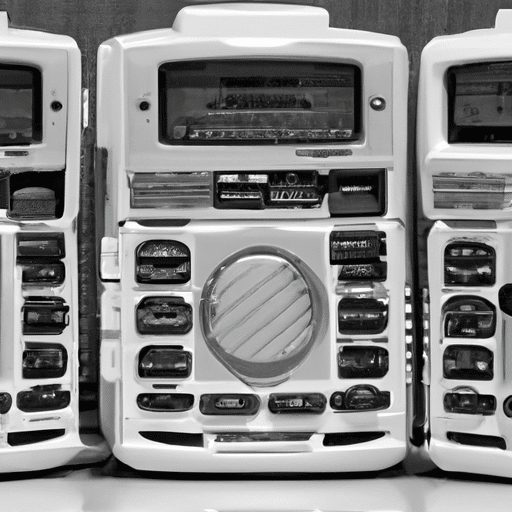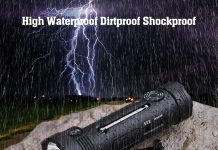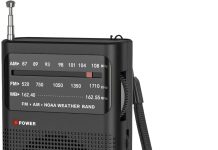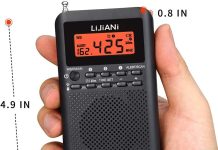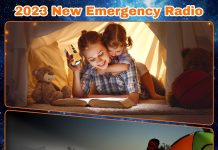When it comes to being prepared for emergencies, having a reliable source of information is crucial. That’s where emergency weather radios come in. These handy devices provide updates on severe weather conditions, helping us stay informed and make important decisions regarding our safety. But the question arises: should we have more than one emergency weather radio? In this article, we will explore the reasons why having multiple radios can be beneficial and enhance our preparedness during emergencies.
Review contents
Importance of Emergency Weather Radios
Why are emergency weather radios important?
Emergency weather radios are crucial tools for ensuring the safety and well-being of individuals and communities in the face of severe weather conditions. These radios provide timely and accurate information about weather alerts, natural disasters, and emergency warnings directly from authorized agencies such as the National Weather Service (NWS). By having an emergency weather radio, we are empowered to make informed decisions and take necessary actions to protect ourselves and our loved ones.
How do emergency weather radios work?
Emergency weather radios utilize the same frequencies used by radio and television broadcasters, enabling them to receive and broadcast weather-related information. These radios are equipped with a special feature called Specific Area Message Encoding (SAME), which allows users to receive alerts specifically tailored to their geographic area. When an alert is issued by the NWS, it is transmitted through these radios, triggering a loud and distinctive alarm tone to warn individuals of impending severe weather or emergency situations.
Benefits of having an emergency weather radio
Having an emergency weather radio offers numerous benefits in ensuring our safety and preparedness during unexpected events. Some key advantages include:
-
Early Warning System: Emergency weather radios provide early warnings for severe weather conditions, giving us the opportunity to seek shelter or evacuate in a timely manner.
-
Accuracy and Reliability: These radios receive alerts directly from official sources, minimizing the risk of misinformation or delayed notifications that may occur through other communication channels.
-
Alert Customization: With SAME technology, emergency weather radios allow us to select specific counties or areas for which we want to receive alerts, ensuring that we are only notified about threats relevant to our location.
-
Battery Backup: Many emergency weather radios are equipped with backup batteries or hand-crank options, ensuring that we can still receive alerts even during power outages or when other communication methods are unavailable.
-
Versatility: These radios often include additional features such as AM/FM radio and flashlight, making them versatile tools that can be used beyond just emergency situations.
Factors to Consider
Location and Geographic Factors
One important factor to consider when deciding on the number of emergency weather radios to have is the location and geographic factors specific to our area. Different regions have varying risks and vulnerabilities when it comes to severe weather, such as hurricanes, tornadoes, or floods. It is essential to understand the unique weather patterns and potential hazards of our location to determine the level of preparedness required.
Personal and Family Needs
Considering our personal and family needs is crucial in deciding if we should have multiple emergency weather radios. Factors such as the size of our household, the number of family members, and their individual mobility and communication needs should be taken into account. Having multiple radios can ensure that each family member has easy access to critical information, especially during emergency situations when communication may be challenging.
Budget and Accessibility
Budgetary constraints and accessibility are practical considerations to determine the number of emergency weather radios we should invest in. While it is ideal to have multiple radios strategically placed throughout our home or community, the cost of purchasing and maintaining them might not be feasible for everyone. Similarly, considering the availability of emergency weather radios and their accessibility in our area is essential, as some regions may have limited options or resources.
Types of Emergency Weather Radios
Handheld Portable Radios
Handheld portable radios are compact devices that are easily carried and operated. These radios are battery-powered and often come with additional features such as AM/FM radio, flashlight, and sometimes even a built-in weather alert siren. Handheld portable radios are convenient for outdoor activities, travel, and situations where mobility is a priority.
Desktop Radios
Desktop radios, as the name suggests, are designed to be placed on a desk or a specific location within a building. These radios are larger and typically require an external power source. They often have more advanced features, including extended battery life, larger speakers for better audio output, and the capability to connect external antennas for improved reception.
Weather Alert Radios
Weather alert radios, also known as NOAA Weather Radios, are specifically designed to receive and broadcast weather-related alerts. These radios are equipped with SAME technology, allowing users to receive alerts tailored to their geographic area. Weather alert radios are typically tabletop or wall-mountable and provide continuous monitoring of weather conditions, automatically activating alerts when necessary.
Two-Way Radios
Two-way radios, also known as walkie-talkies, enable two-way communication between users over short distances. While they do not have the same functionality as weather-specific radios, they can still be useful during emergencies to communicate with neighbors, family members, or emergency responders. Two-way radios are portable, battery-operated devices that can provide an additional communication option in situations where traditional methods might not be available.
Advantages of Having Multiple Radios
Redundancy in Emergency Situations
Having multiple emergency weather radios offers redundancy, ensuring that even if one radio fails or is out of reach, we still have access to critical information. During severe weather events or emergencies, having a backup radio increases the likelihood of receiving important alerts and updates, thus minimizing the risk of missing vital information.
Enhanced Coverage and Reception
Different radios may vary in their coverage range and reception capabilities. By having multiple radios strategically placed in various locations, we can enhance our coverage area, improving the chances of receiving alerts and maintaining communication. This is particularly important in large households or areas where signal strength might be compromised.
Multiple Locations and Use Cases
Having multiple emergency weather radios allows us to place them in different areas within our home or community, catering to varying use cases. For example, we may choose to have a desktop radio in the living room for continuous monitoring and an easily accessible handheld radio for outdoor activities or travel. This flexibility ensures that critical information is readily available, regardless of our location or circumstances.
Disadvantages of Having Multiple Radios
Added Cost and Maintenance
One of the primary disadvantages of having multiple emergency weather radios is the added cost associated with purchasing and maintaining them. Each radio requires batteries or a power source, and there may be additional expenses for accessories such as external antennas or protective cases. It is important to consider the financial implications and weigh them against the potential benefits before deciding to invest in multiple radios.
Confusion and Overwhelm
Having multiple radios can lead to confusion and overwhelm, especially if they have different alert tones or display information in different formats. It is essential to ensure that each member of our household understands how to operate the radios and interpret the information received. Furthermore, during emergency situations, the simultaneous activation of multiple radios can add to the stress and anxiety already being experienced.
Limited Emergency Resources
Having multiple radios does not guarantee access to additional emergency resources beyond the information provided. In situations where emergency services or resources are limited, it is crucial to prioritize their allocation to those in immediate need. Relying solely on multiple radios for emergency assistance may lead to a false sense of security, as they are primarily meant to provide alerts and information rather than direct assistance during emergencies.
Alternative Approaches
Utilizing Smartphone Applications
Smartphone applications can serve as an alternative or complementary approach to emergency weather radios. Many weather applications offer real-time alerts and updates based on our location, providing a convenient and portable solution. However, it is important to note that relying solely on smartphone applications may pose challenges in cases of power outages, limited internet connectivity, or when other communication channels are inaccessible.
Community and Neighborhood Collaboration
Collaborating with neighbors and the local community can be a valuable approach to enhance emergency preparedness without the need for multiple radios. Establishing a network where neighbors share information, updates, and alerts can provide a collective support system during emergencies. This can include utilizing social media groups, neighborhood associations, or even designated communication channels within a community.
Accessing Multiple Information Sources
While emergency weather radios are designed to provide accurate and timely information, it is always beneficial to access information from multiple sources. This can include monitoring local news stations, online news platforms, or subscribing to emergency alert systems provided by government agencies. Utilizing a combination of different sources helps to cross-validate information and ensure a comprehensive understanding of the situation.
Expert Recommendations
Advice from Emergency Management Agencies
Emergency management agencies stress the importance of being prepared and having access to reliable information during emergencies. While they recognize the benefits of having multiple emergency weather radios, they emphasize the need for a balanced approach that aligns with individual needs and resources. These agencies typically recommend having at least one emergency weather radio as a fundamental preparedness measure.
Insights from Weather Professionals
Weather professionals, such as meteorologists and climatologists, often highlight the significance of emergency weather radios in receiving timely alerts and updates. Their insights reinforce the necessity of having access to reliable information sources that can help individuals make informed decisions and take appropriate actions during severe weather events.
Experiences of Emergency Responders
Emergency responders, who are at the front lines during emergencies, recognize the value of emergency weather radios in supporting their work. These professionals rely on accurate and up-to-date information to coordinate their response efforts effectively. Their experiences reinforce the importance of having reliable communication channels, such as emergency weather radios, that can provide critical information to communities.
Personal Assessments
Assessing Your Risks and Vulnerabilities
Conducting a personal assessment of our risks and vulnerabilities is an essential step towards determining the number of emergency weather radios we should have. Factors such as the frequency and severity of past weather events, proximity to potential hazards, and the presence of vulnerable individuals in our household can significantly impact our level of preparedness. By recognizing these factors, we can make a more informed decision regarding the number of radios required.
Considering Local Weather Conditions
Understanding the local weather conditions and patterns is essential in the decision-making process. Different regions face distinct weather challenges, and some may be more prone to certain types of severe weather events than others. By considering the historical data and trends specific to our area, we can better assess the need for multiple emergency weather radios.
Assessing Reliability of Local Emergency Systems
Evaluating the reliability of our local emergency systems is crucial. While emergency weather radios are designed to provide accurate and timely alerts, it is important to ensure that the local infrastructure and support systems are also dependable. Assessing factors such as the responsiveness of emergency services, the availability of alternative communication channels, and the effectiveness of evacuation plans can inform our decision.
Final Decision-making Factors
Determining Your Risk Tolerance
Determining our risk tolerance is a key factor in deciding the number of emergency weather radios we should have. Some individuals may have a higher tolerance for risk and may opt for a minimalistic approach, relying on a single radio or alternative communication methods. Others may have a lower risk tolerance and prefer the added assurance of having multiple radios to increase their chances of receiving critical information.
Balancing Convenience with Preparedness
Balancing convenience with preparedness is another crucial consideration. While having multiple radios can enhance our preparedness level, it is important to find a balance that suits our lifestyle and preferences. We should evaluate our daily routines, mobility, and accessibility needs to determine if multiple radios are practical and feasible for our household.
Considering the Size of Your Household
The size of our household plays a significant role in deciding the number of emergency weather radios we should have. Larger households with multiple family members may benefit from having additional radios, ensuring that each individual has easy access to critical information. Conversely, smaller households may find that a single emergency weather radio is sufficient to meet their needs.
Conclusion
Reviewing the pros and cons and carefully considering the numerous factors discussed can help us make an informed choice regarding the number of emergency weather radios to have. While having multiple radios offers redundancy, enhanced coverage, and flexibility, it also comes with added costs, potential confusion, and limited emergency resources. It is crucial to assess our risks, consider local weather conditions, and evaluate personal and family needs before deciding the level of preparedness that is right for us. By taking action and prioritizing our safety through the use of emergency weather radios, we can better protect ourselves and our loved ones during times of severe weather and emergencies.

